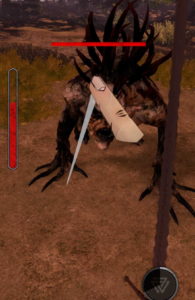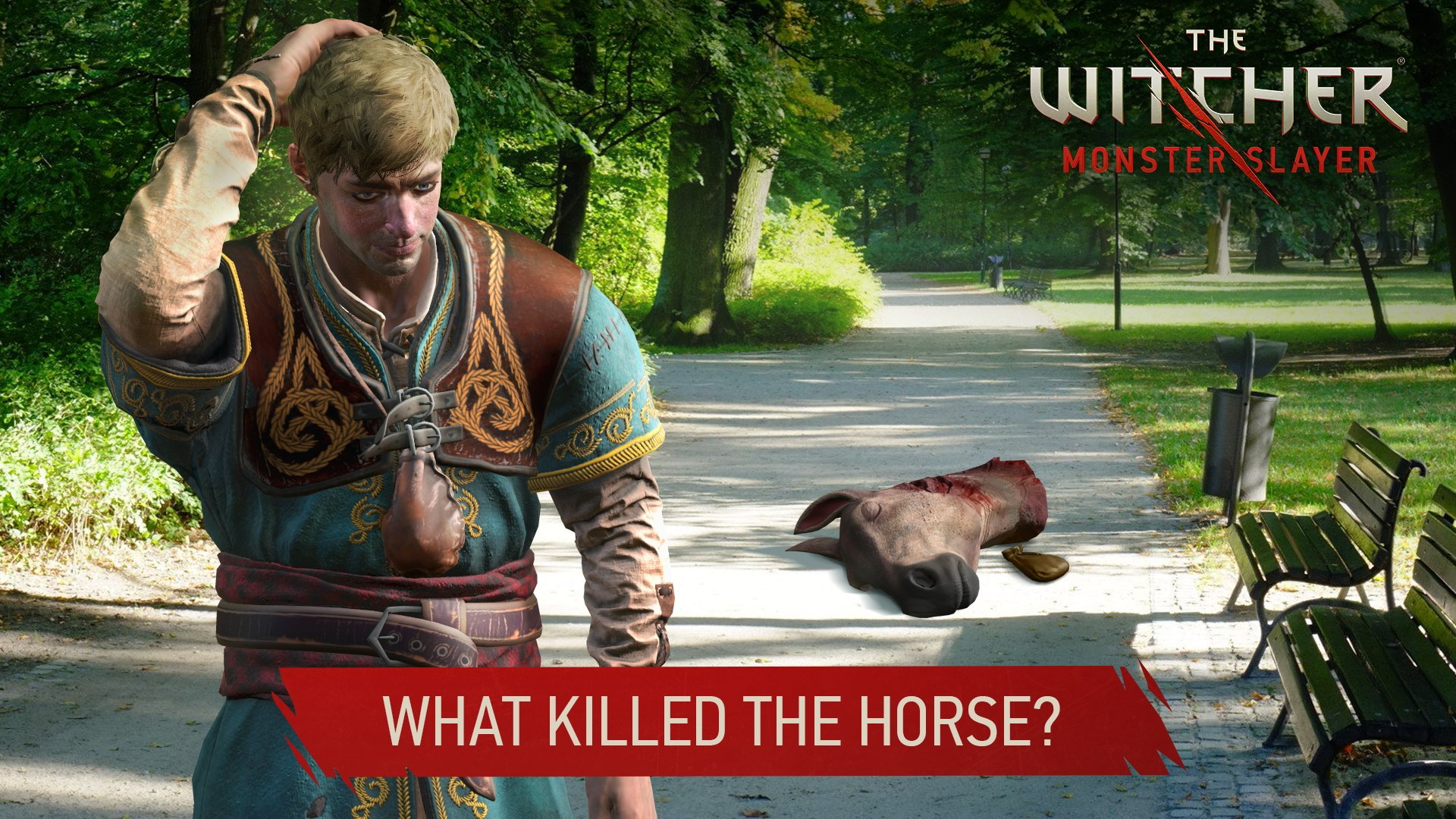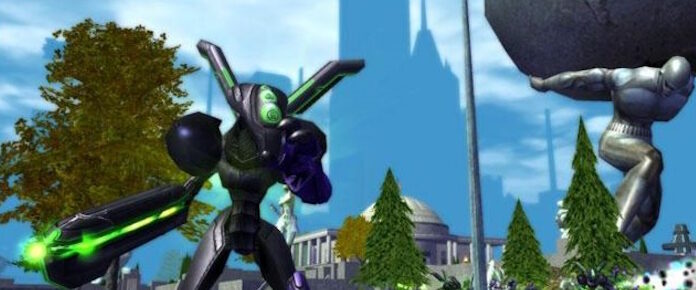
Nearly a year ago, Niantic employees did a GDC presentation on Augmented Reality design practices, though it seemed a bit more like best practices than exactly what the company does in reality. While I may complain about Pokemon Go design issues, I wouldn’t be playing if the game weren’t good. It can always be better, but I don’t want to hold good design hostage to dreams of perfect.
So while there are other AR games that do some really cool things that I wish Niantic would add into POGO (or other IPs), The Witcher: Monster Slayer doesn’t have a lot of that. Much of the gameplay is very similar to POGO mechanics but with bits and pieces taken from other mobile games. For anime fans who remember Sword Art Online: Ordinal Scale and thought, “Wow, I’m glad this is an anime and not a real game,” well, this game may vaguely remind you of some of that proposed gameplay, especially quests that direct you to real-world locations. While the game is practically single-player (I don’t consider sending gifts true multiplayer) and so less problematic about its monetization, the basic AR features are ill-fitted to gaming in the real world, with only one saving grace.
Don’t be weird in public
Story in mobile games rarely feels engaging, especially among top-grossing games. Outside of TellTale Games, I can think of only one other title that surprised me with its story apart from Genshin Impact (if you forget about the gacha mechanics). Especially after Netflix really brought The Witcher to new audiences, one would hope an accessible mobile game might do that as well.
I wish I could tell you the game brought me something fresh and memorable, but from what little I saw, it was fairly straightforward. For a mobile title, bringing voice acting and illustrated cutscenes would be impressive, but when a game asks you to walk a mile or more outside to do a quest, it’s hard not to blast past story so you’re not longer standing on a street corner attracting unwanted attention. Voice acting in particular could be nice, but many mobile gamers I know in the US play with the sound off anyway, so it’s wasted effort on most of them.
While Pokemon Go‘s Professor Willow does deserve a voice, I think Niantic’s animated but strictly text-driven vignettes better serve its playerbase. A story-heavy YouTube video would be cool, like Overwatch, except with a real in-game story and not just flavor for external stories. This keeps players engaged with the action parts of the game but also keeps players inconspicuous. Granted, POGO players already do stand out, but The Witcher: Monster Slayer keeps quests outside at fixed locations (which we’ll get into later).
Although Pokemon Go quests can’t exactly be done anywhere, they’re fairly flexible in location so that you can move elsewhere to do what you need to do. Remember, as the team put it, AR is in shared spaces. Niantic says AR games should make the players keep moving and using active gestures while aiming their phones at the ground or sky, to help illustrate they’re playing a game. The idea is this helps make sure no one gets too uncomfortable, but it starts by assuming the player is comfortable gaming in real life. That’s not always the case, and acting “suspiciously” is dangerous for some users.
 Obviously, POGO raids and gyms are an exception to this rule, but you have a nice wide radius that gives you plenty of room to find a safe place to stand and play if need be (at least until Niantic nerfs it). POGO players who aren’t using the AR+ for catching also have a rather simple move for catching, and I feel it’s much easier to play with one hand than some other titles, which can help the player look more like a regular member of society than like someone slowly becoming a Pokemon master.
Obviously, POGO raids and gyms are an exception to this rule, but you have a nice wide radius that gives you plenty of room to find a safe place to stand and play if need be (at least until Niantic nerfs it). POGO players who aren’t using the AR+ for catching also have a rather simple move for catching, and I feel it’s much easier to play with one hand than some other titles, which can help the player look more like a regular member of society than like someone slowly becoming a Pokemon master.
Again, if I leave out TWMS’s AR fighting option, basic combat is more involved than what’s found in POGO or even The Walker Dead: Our World. It’s fun, no doubt about that. Quick swipes to do quick attacks, slower-paced ones for strong, left and right for horizontal cuts, up or down for vertical, long press to parry, tap a button for bombs, tap another and making a sign for spells. It’s fun and forgiving, and the combat pacing is perfect (if I set aside that consumables are partially monetized, but the function is good). And this is ignoring the talent trees, which can give you new moves or neat utilities, like damage reflection from blocking or delaying real-time attacks by a second.
However, this makes the player stand out more than throwing balls and requires more concentration. While I feel TWMS is smarter by having fewer monsters all over the place and making interactions meaningful, you’re not just playing on the bus or something in an AR game; you’re playing in areas people walk, talk, and socialize (if you’re lucky). I can walk and catch pokemon with friends, but I felt awkward and anti-social trying to slay monsters with my friend. I’d much rather do that at home than in public, and TWMS has you really going out in public to play – and not always in a safe way.
Let the player lead, not the game
One thing Niantic’s employees didn’t mention during that talk was playing in unsafe areas. Again, Niantic has long-running issues when it comes to this problem. People die playing this game, and while the company can warn people all they want, incentivizing real-life actions via a game has consequences even when you use an EULA, which Snapchat is learning about the hard way.
In Niantic games, there may be a Portal to capture or gym to take in a restricted area or shady part of town to be playing at during the night. There’s temptation to go there at all hours. However, TWMS may “randomly” put your quest there. It seems like it gets worse, as one Twitter user noted a quest wanted him to return to a quest location at dawn. I’ve had the game direct me into people’s fenced-off yards, gated communities, the back pickup/garbage area of a mall, a busy parking lot, a hill known for land/mudslides, a construction site, and busy streets.
One of the issues is that this isn’t like POGO where you can see Squirtle happily waiting for you to capture it. It may give you a wide, unsafe space and direct you to explore it. When that’s a residential area you don’t live in, and you don’t look like your anti-social neighbors who don’t know that you live in the same community as them, you may be in for a bad time. That’s how people die.
It’s immensely disheartening that a developer would put this kind of feature into an AR game when it’s been covered by mainstream media. I’m used to devs not really knowing what’s going with gaming outside of AAA titles, but POGO crimes still make mainstream media news, and I would think any reasonable company would at least have someone looking out for these kinds of issues.
Now, TWMS does have a button to change your quest location, but I’ve seen people miss the button, which is hidden in the journal section of the game. Worse, being close to the quest area makes you unable to use this feature. This means you may walk a mile or more to a quest area only to find out you can’t play in that area. Not only is this unsafe for walking players, but it may simply encourage people to drive and play, which from the game’s warnings is not the way the game should be played.
Admittedly, it may be the devs’ way of trying to motivate people to walk. POGO does this as well, but when you need to travel a certain distance, you then activate the quest at your leisure. This ensures that you can do your quest completions wherever you’re comfortable rather than on the spot. And there’s certainly no time-based quests. While there are certain actions, such as evolving a pokemon at night, there are huge windows of opportunity and can be done anywhere safely.
Clear but exciting rewards
I will say that one thing both games do well is have good rewards players can often understand. While “epic loot” in POGO is basically new, shiny, or hatted pokemon, you can’t always visibly tell if what you got is something good.
TWMS makes things fairly clear. No damage ranges, armor ratings, dodge percents, nothing like that. Loot does will offer things like a free consumable effect without having to use the consumable, lower spell cast times, or even straight-up XP bonuses. Granted, there isn’t any randomly generated loot, so it’s probably a bit easier, but I still feel like I could show TWMS loot to a casual gamer and he could more easily figure out what he wanted than if I showed him two MMO swords of the same item level and asked for his preference.
It’s a small but key thing, especially as the power of ARs is that they’re played in the real world by a physically mobile gamer, so the games have more physical exposure and potential to rope in more players, particularly players from non-gaming or limited gaming backgrounds. The problem is that many of these games take things from traditional gaming and try to make them work in a real-life setting. While concepts like dailies and base capping are simple enough, design like hidden combat mechanics and arbitrary damage numbers is just confusing for casual players whose idea of games is limited to Candy Crush and Mario Bros.
Being inclusive of other styles is the advantage of the AR game, and while I can’t say The Witcher: Monster Slayer isn’t fun, I can say that I wouldn’t recommend it as an AR game, especially in its current non-multiplayer form. Walking around swiping my screen like mad is embarrassing and doesn’t feel social, and being directed to walk to places the game doesn’t seem to recognize as unsafe feels irresponsible, especially when the game prevents relocating quests when you’re “too close” to an unsafe spot the game directed you to. Maybe if there were more of that neat loot around that I could grab with people, it could appeal to a larger audience. But then its monetization issues, such as XP-granting armor and a whole talent tree dedicated to RL-purchasable consumables which trivialize content, would stand out even more.
 Massively OP’s Andrew Ross is an admitted Pokemon geek and expert ARG-watcher. Nobody knows Niantic and Nintendo like he does! His Massively on the Go column covers Pokemon Go as well as other mobile MMOs and augmented reality titles!
Massively OP’s Andrew Ross is an admitted Pokemon geek and expert ARG-watcher. Nobody knows Niantic and Nintendo like he does! His Massively on the Go column covers Pokemon Go as well as other mobile MMOs and augmented reality titles!

















